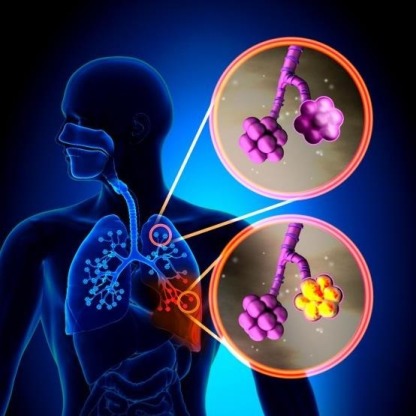The pneumonia is a common disease of the respiratory system, often derived from a previous infection, such as flu or strep throat. Although pneumonia can be cured also it can have serious consequences if not properly diagnosed or treated, being responsible for a high number of deaths per year.
Pneumonia is a disease that affects both adults and children, so we must be alert to the presence of this symptoms. In this article we will detail to you what are the signs of this respiratory condition, why arises and how its treatment is.
Basically it involves inflammation of the lungs as a result of an infection caused by a virus or bacteria. As we know in the following sections, symptoms tend to be characteristic to severe pain usually occur on the affected side of the chest.
In addition, it becomes one of the infections that commonly cause the hospitalization.
Pneumonia occurs when there is an infection of the lung tissue. Pneumonia generates inflammation of the alveoli, causing the entry of fluid and infectious material.
Since the cells are part of the lung where the air is filtered, achieving transmits oxygen to the blood and disposing of carbon dioxide, this generates serious consequences.
Risk factors for pneumonia
While anyone can get pneumonia, there are some risk factors that increase the chances of contracting the disease. Therefore it is advisable, whenever possible, to avoid such situations.
The first is the smoking, as we know; it is highly detrimental to health, especially for our respiratory system. Also alcoholism, malnutrition and excess weight are also risk factors.
Other risk factors of pneumonia are related to other health problems such as certain chronic diseases, including heart disease, liver, kidney and chronic lung, AIDS, cancer and diabetes mellitus.
Also in patients with low defenses, for example because of having suffered the spleen removal, for treatment with immunosuppressants or steroids for prolonged periods.
Typical symptoms of the pneumonia
Let us note now the most common symptoms of pneumonia, something we should keep in mind to not let time pass and turn to an early medical consultation.
People suffering from pneumonia develop fever, cough with phlegm and frequently chest pain, especially when breathing.
This pain is usually intense and appears especially on the side of the chest where the inflammation is located. Patient may also feel agitation of breathing and increased frequency of heartbeat.
In a smaller proportion of cases there are other symptoms, it is called atypical pneumonia. Among them, dry cough (without sputum), body aches, especially in joints and muscles. It is also common in these cases feel headache or gastrointestinal discomfort.
Pneumonia treatment
First professional should diagnose the presence of the disease, usually from the symptoms described by the patient and listening to the sounds that occur during breathing. It is usual that prompted a chest x-ray for a lung image.
Depending on the case and severity may decide hospitalization or – not to be necessary – becomes the home treatment with regular checks.
Patients at greatest risk as the over 65 age or those suffering from chronic diseases such as those we already mentioned, usually perform the treatment being hospitalized for their increased risk.
Pneumonia, to be transmitted by bacteria (different varieties of Pneumococcus) can be treated with antibiotics. The earlier to start take the medication, the better the patient’s recovery.
At the same time, during the treatment of pneumonia should take rest and fluid intake in required quantity.
